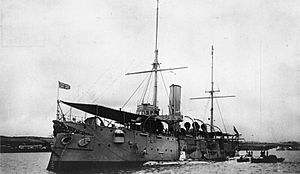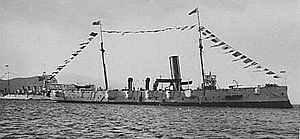HMS Thames (1885) facts for kids

Thames at anchor with what is probably an A-class submarine berthed next to her
|
|
Quick facts for kids History |
|
|---|---|
| Name | HMS Thames |
| Namesake | River Thames |
| Builder | Pembroke Dockyard |
| Laid down | 14 April 1884 |
| Launched | 3 December 1885 |
| Completed | July 1888 |
| Reclassified | Submarine depot ship, 1903 |
| Fate | Sold, 13 November 1920 |
| Name | SATS General Botha |
| Namesake | Louis Botha |
| Christened | 1 April 1922 |
| Acquired | 13 November 1920 |
| Commissioned | March 1922 |
| Decommissioned | 1942 |
| Renamed | Thames, 1942 |
| Reclassified |
|
| Homeport | Simon's Town |
| Fate | Scuttled, 13 May 1947 |
| General characteristics | |
| Class and type | Mersey-class second-class cruiser |
| Displacement | 4,050 long tons (4,110 t) |
| Length | 300 ft (91.4 m) (p/p) |
| Beam | 46 ft (14.0 m) |
| Draught | 20 ft 2 in (6.1 m) |
| Installed power |
|
| Propulsion |
|
| Speed | 18 kn (33 km/h; 21 mph) |
| Range | 8,750 nmi (16,200 km; 10,070 mi) at 10 knots (19 km/h; 12 mph) |
| Complement | 300–50 |
| Armament |
|
| Armour |
|
HMS Thames was a special type of protected cruiser built for the Royal Navy (RN) in the 1880s. A protected cruiser was a warship with an armored deck to protect its important parts. When she was finished in 1888, the ship was kept in a "reserve fleet," meaning she was ready to be used if needed.
In 1903, Thames was changed into a submarine depot ship. This meant she became a floating base for submarines, helping them with supplies and repairs. She was sold by the navy in 1920. A businessman from South Africa bought her to use as a training ship for young naval cadets. She was renamed SATS General Botha.
The ship arrived in South Africa in 1921. She started training her first group of cadets in Simon's Town the next year. General Botha kept training cadets during the first few years of World War II. However, the Royal Navy took over the ship in 1942. They used her as an accommodation ship, which is like a floating hotel for sailors. She went back to her original name, Thames. In 1947, she was sunk on purpose by gunfire. Today, she is a popular wreck for divers to explore.
Contents
Ship Design and Features
The Mersey-class cruisers, like Thames, were designed to protect British merchant ships around the world. They were an improved version of an earlier ship class. These cruisers were about 300 feet (91.4 m) (91.4 meters) long. They were 46 feet (14.0 m) (14 meters) wide and sat about 20 feet 2 inches (6.1 m) (6.1 meters) deep in the water. The ship weighed about 4,050 long tons (4,110 t) (4,115 metric tons).
Thames was powered by two large steam engines. These engines turned two propellers, allowing the ship to reach a top speed of 18 knots (33 km/h; 21 mph) (about 33 kilometers per hour). The steam for the engines came from twelve large boilers. The ship could travel a very long distance, about 8,750 nautical miles (16,200 km; 10,070 mi) (16,200 kilometers), at a slower speed of 10 knots (19 km/h; 12 mph) (19 kilometers per hour). This was important for long voyages. A crew of 300 to 350 officers and sailors worked on board.
Ship's Weapons and Protection
The main weapons on Thames were two large 8-inch (203 mm) (203 mm) guns. One was at the front of the ship and one at the back. She also had ten 6-inch (152 mm) (152 mm) guns, five on each side of the ship. These guns were placed in special areas that stuck out from the ship's sides.
To defend against smaller, faster torpedo boats, Thames carried six smaller, quick-firing guns. These included three 6-pounder guns and three 3-pounder guns. The ship also had two 14 in (356 mm) (356 mm) torpedo tubes below the waterline, which could launch torpedoes at enemy ships.
For protection, Thames had an armored deck. This deck was 2 inches (51 mm) (51 mm) thick on flat parts and 3 inches (76 mm) (76 mm) thick on sloped parts. This armor helped protect the ship's vital machinery. The conning tower, where the ship was steered, had very thick armor, 9 inches (229 mm) (229 mm) thick.
Thames was the sixth ship in the Royal Navy to carry that name. Her construction began on 14 April 1884 at Pembroke Dockyard. She was officially launched into the water on 3 December 1885. The ship was fully completed in July 1889.
After being finished, Thames was immediately placed in reserve at Devonport. This meant she was ready for service but not actively deployed. In 1902, she was briefly put into service as a port guard ship at Queenstown.
In 1903, Thames was changed into a submarine tender. This new role meant she would support submarines. She served in this role at Sheerness from 1907 to 1917. Later, she moved to Portsmouth and Campbeltown, Scotland. In 1919, she was officially taken out of service at Chatham Dockyard.
A New Purpose: Training Sailors in South Africa
In November 1920, Thames was sold for £8,000. A businessman named T. B. Davis, from South Africa, bought her. He wanted to honor his son, who had died during World War I. The ship went to Tilbury for some quick repairs. Thames was then renamed Training Ship (TS) General Botha. This new name honored Louis Botha, who was the first Prime Minister of the Union of South Africa.
Journey to South Africa
Before leaving for South Africa, important people visited the ship. On 6 January 1921, the ship sailed from Plymouth. She ran into a big storm in the English Channel. The storm damaged parts of the ship, forcing her to return to Plymouth for repairs.
After repairs, General Botha set sail again on 8 February. She arrived in Cape Town on 26 March. There, she was welcomed by the Minister of Defence and other important figures.
Becoming a Training Ship
On 9 May, Mr. Davis gave the ship to a special trust. He said the ship must only be used to train British and South African boys for a life at sea. The Royal Navy helped by paying for the changes needed to turn General Botha into a training ship. They also towed her to Simon's Town Naval Dockyard and gave her a place to dock.
The first group of 75 boys started their two-year training program on 15 March 1922. The ship was officially named South African Training Ship (SATS) General Botha on 1 April. The wife of Prime Minister Jan Smuts christened the ship. On 15 December, King George V became the ship's patron. He even sponsored a special gold medal each year for the best cadet.
In May 1925, Edward, the Prince of Wales, visited and inspected the boys and the ship. About a month later, the ship went into dry dock. Her engines and funnel were removed. The inside was changed to create new sleeping areas, kitchens, and recreation spaces. She returned to her dock in August.
In March 1935, Mr. Davis offered to pay for a rowing competition. Cadets from General Botha would race against cadets from British training ships, HMS Worcester and HMS Conway. The General Botha cadets traveled to Britain for the race. King George V met them at Buckingham Palace. In the race, they beat Conway but lost to Worcester. By the late 1930s, General Botha had lost her guns and boilers. The old engine rooms were turned into a gymnasium.
World War II and Final Resting Place
When World War II began, the ship's Board of Control offered General Botha to the Royal Navy. The offer was first declined. However, in July 1942, the Royal Navy decided to take the ship. The boys and staff moved ashore on 28 July. The ship then went back to her original name, Thames.
She was used as an accommodation ship, providing living space for sailors. For some time, she was also used as a prison ship. By the time the Royal Navy returned her to the Board of Control, she was too old and expensive to repair.
On 13 May 1947, Thames was sunk on purpose. She was scuttled by gunfire from a local coast defence battery in False Bay. Her coordinates are 34°13′48″S 18°37′48″E / 34.23000°S 18.63000°E.
Today, there is an alumni association for those who trained on General Botha. The Duke of Edinburgh is their patron. The South African Naval Museum in Simon's Town has a special display about the ship.
See also



